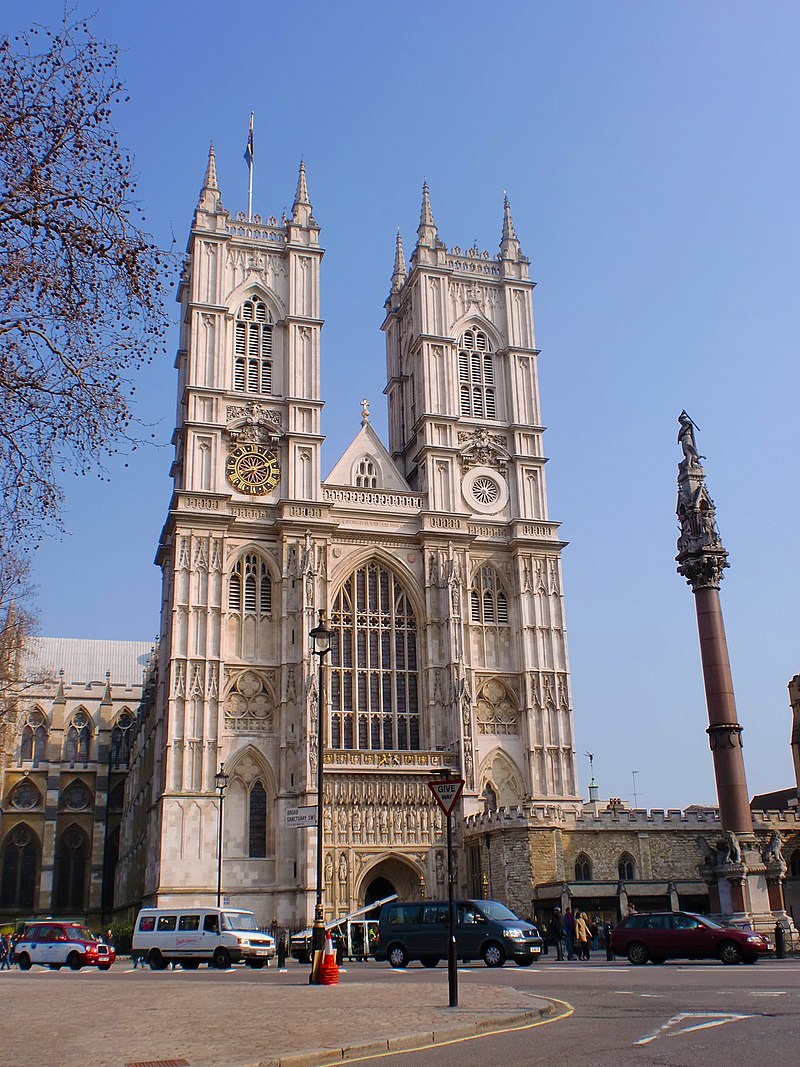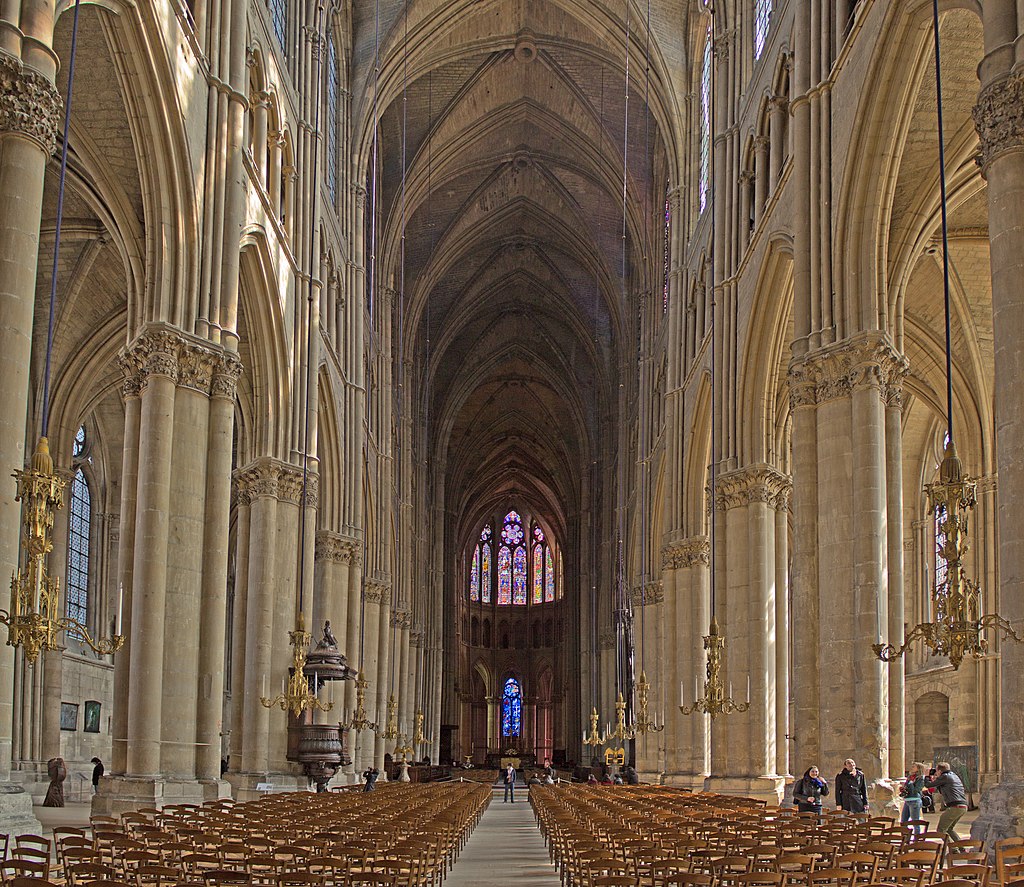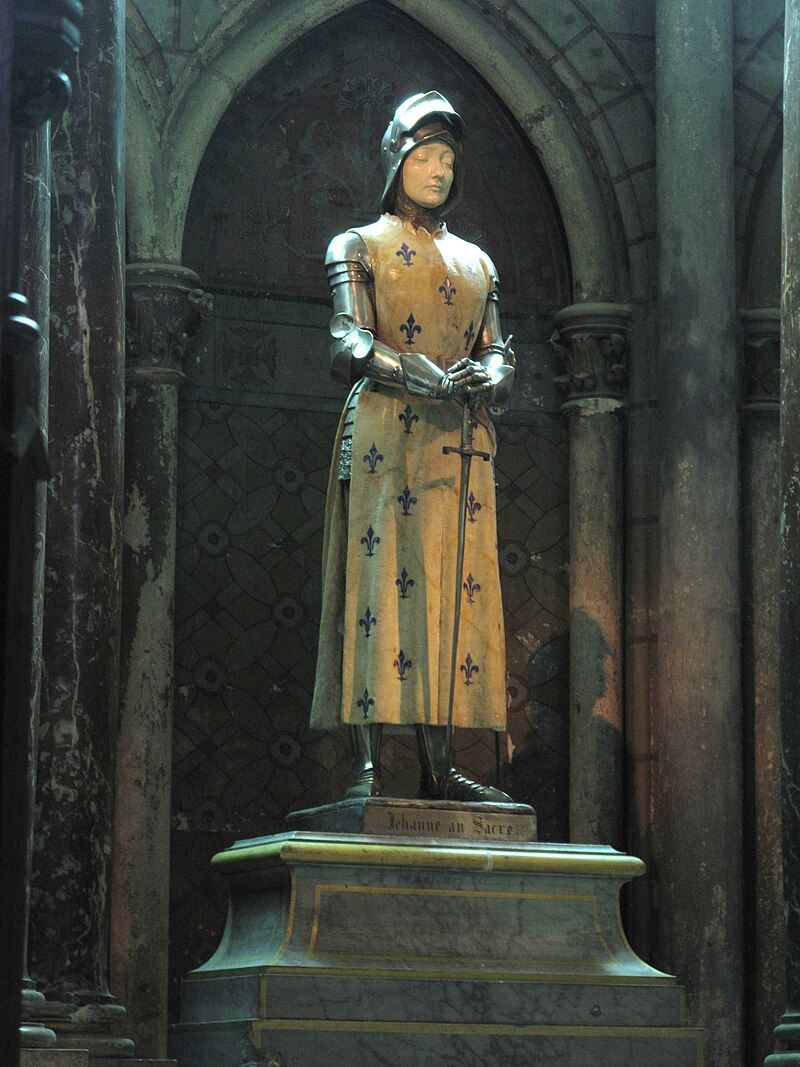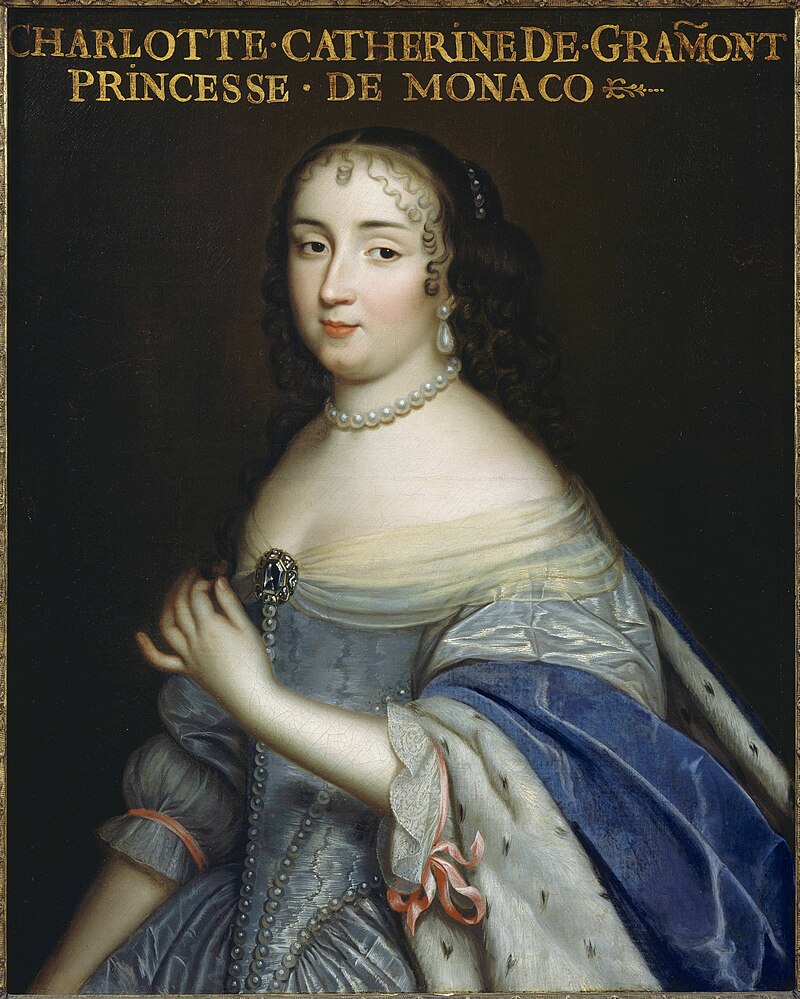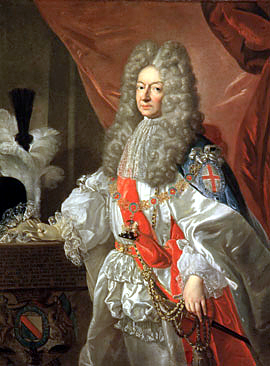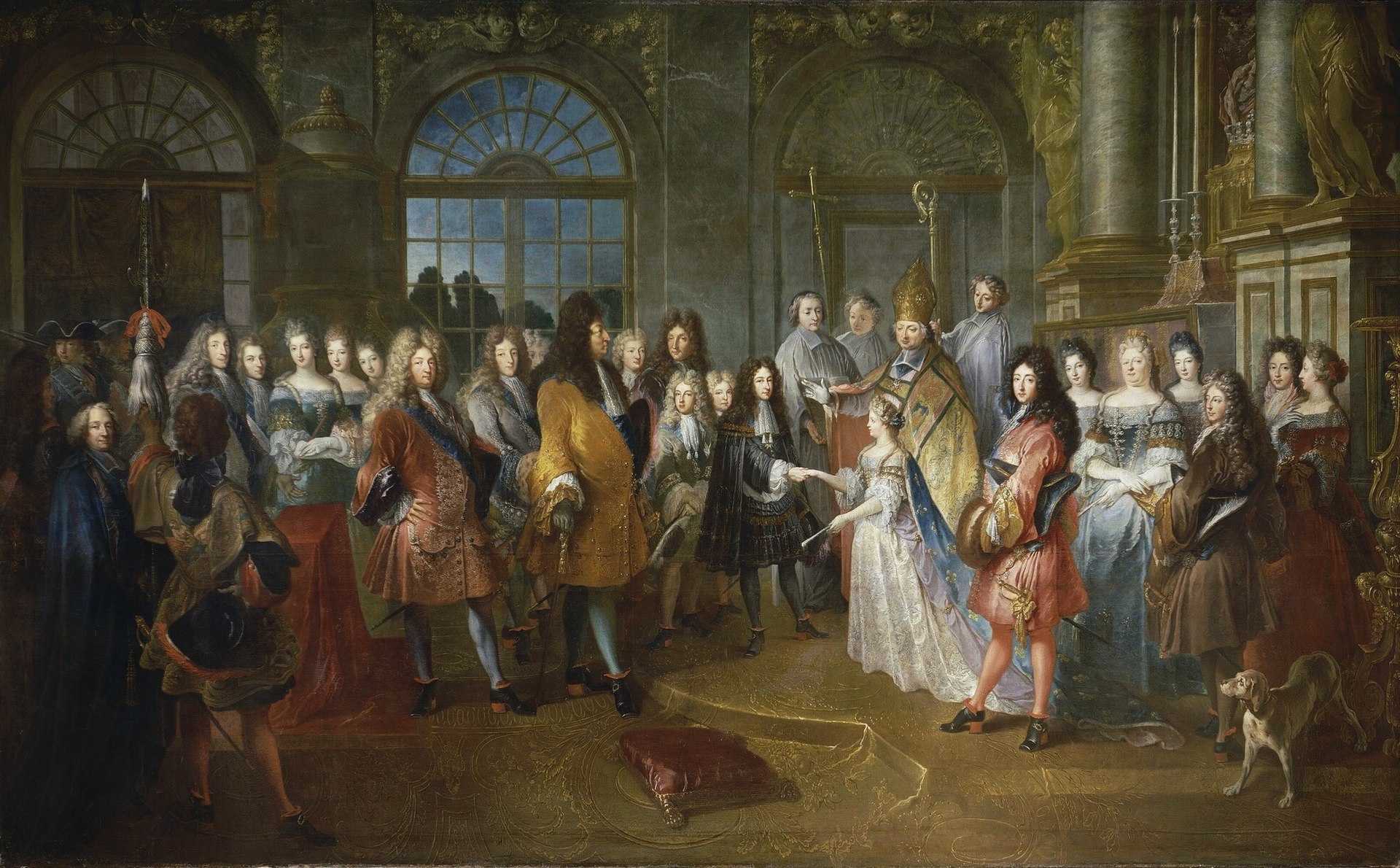by Susan Flantzer
© Unofficial Royalty 2022

Antonio I, Prince of Monaco; Credit – Wikipedia
Born on January 25, 1661, in Paris, France, Antonio I, Prince of Monaco was the elder of the two sons and the eldest of the six children of Louis I, Prince of Monaco and Catherine-Charlotte de Gramont. Hercule Grimaldi, Marquis of Baux, who predeceased his father Honoré II, Prince of Monaco, and Maria Aurelia Spinola from the House of Spinola, a powerful and influential family from the Republic of Genoa, were his paternal grandparents. His maternal grandparents were Antoine III de Gramont, Duke of Gramont, a French military commander, diplomat, and a Marshal of France, and Françoise Marguerite du Plessis, a niece of powerful Cardinal Richelieu (Armand Jean du Plessis, Duke of Richelieu), who served as the First Minister of State to King Louis XIII of France from 1624 until his death in 1642.
Antonio had five younger siblings:
- Maria Teresa Carlotta Grimaldi (1662 – 1738), twin of Jeanne Maria, a Visitandine nun in Monaco, later Abbess of the Visitandine convent in Monaco
- Jeanne Maria Grimaldi (1662 – 1741) twin of Maria Teresa, a Visitandine nun in Monaco, later Abbess of the Abbey of Royallieu near Compiègne, France
- Teresa Maria Aurelia Grimaldi (1663 – 1675), died in childhood
- Anna Hippolyte Grimaldi (1664 – 1700), married Jacques de Crussol, Duc d’Uzès, no children
- François Honoré Grimaldi, Archbishop of Besançon (1669 – 1748 – link in French)
In 1641, during the reign of Antonio’s great grandfather Honoré II, Monaco had become a French protectorate, and the Princes of Monaco became vassals of the Kings of France while remaining sovereign princes. Many successive Princes of Monaco and their families spent most of their lives in France and intermarried with French and Italian noble families, including Antonio’s father Louis. King Louis XIV of France was four years older than Louis and was his contemporary.

Marie of Lorraine, Princess of Monaco; Credit – Wikipedia
On June 13, 1688, in the Chapel Royal at the Palace of Versailles in Versailles, France, Antonio married Marie of Lorraine, the daughter of Louis of Lorraine, Count of Armagnac and Catherine de Neufville. Marie’s father was a member of the House of Guise, a cadet branch of the House of Lorraine, and held the rank of prince étranger at the French court. Her mother was the daughter of Nicolas de Neufville, Duke of Villeroy, a Marshal of France and the governor of King Louis XIV during his childhood. Both King Louis XIV and his morganatic second wife Françoise d’Aubigné, Marquise de Maintenon approved of the marriage. Louis XIV gave the couple a chateau just outside of Paris as a wedding gift. The marriage was not happy. Antonio had affairs and illegitimate children and Marie responded by finding lovers of her own.

Louise Hippolyte, Antonio’s eldest surviving daughter and successor; Credit – Wikipedia
Antonio and Marie had six daughters but only two survived to adulthood. The elder surviving daughter Louise Hippolyte succeeded her father as the reigning Princess of Monaco.
- Caterina Charlotte, Mademoiselle de Monaco (1691 – 1696), died in childhood
- Louise Hippolyte, Princess of Monaco (1697 – 1731), married Jacques François Goyon, Count de Matignon, later Jacques I, Prince of Monaco, had nine children, died from smallpox
- Elisabetta Charlotte, Mademoiselle de Valentinois (1698 – 1702), died in childhood
- Margherita Camilla, Mademoiselle de Carlades (1700 – 1758), married Louis de Gand de Mérode de Montmorency, Prince of Isenghien (his third marriage), no children
- Maria Devota, Mademoiselle des Baux (1702 – 1703), died in childhood
- Maria Paolina Theresa Devota, Mademoiselle de Chabreuil (1708 – 1726), unmarried, died at age 18
In addition, in what seems to have become a Grimaldi tradition, Antonio had several illegitimate children from different affairs. He acknowledged the following three:
with Elisabeth Dufort-Babé, a dancer at the Paris Opera:
- Antonio Grimaldi, Chevalier de Grimaldi, Governor-General of Monaco (1697 – 1784), unmarried, the de facto ruler of Monaco from 1732 – 1784
with Victoire Vertu, a dancer at the Paris Opera:
- Antoinette Grimaldi, Mademoiselle de Saint-Rémy
with an unidentified Provençal woman:
- Louise Marie Therese Grimaldi (1705 – 1723)
In 1692, when Antonio was serving in the French military, his wife Marie was sent to Monaco. Upon Antonio’s discharge from the military, Marie insisted upon returning to France. She caused a great scandal when she claimed her father-in-law Louis I, Prince of Monaco made unwanted sexual advances to her. Whether this was true or not, Marie and Antonio returned to the French court. Marie and Antonio’s relationship did not improve. They did reconcile in 1696, when their only child, five-year-old Caterina Charlotte, Mademoiselle de Monaco, died. Marie’s mother and King Louis XIV insisted that Marie and Antonio reunite to provide Monaco with an heir. In 1697, Marie and Antonio returned to Monaco. For the most part, Antonio remained in Monaco for the rest of his life. The couple did have more children between 1697 and 1708, five daughters, but no sons, and only two of the daughters survived to adulthood.
In 1701, upon the death of his father, Antonio became the Sovereign Prince of Monaco. With the help of André Cardinal Destouches, a French composer and manager of the Académie Royale de Musique (the Paris Opera), Antonio brought singers, dancers, and musicians from Paris to Monaco. He had a large room in the Prince’s Palace in Monaco converted into a concert hall with a stage where he conducted musical programs.
Antonio’s greatest concern was the future of the House of Grimaldi. Because Antonio’s only legitimate children were all daughters, the heir to the throne was his only brother François Honoré Grimaldi, a Catholic priest with the title Monsieur l’Abbé de Monaco, later Archbishop of Besançon. In 1715, François Honoré renounced his claims to the throne of Monaco and Antonio’s elder daughter Louise Hippolyte became his heir. Antonio decided, with the permission of Louis XIV, that Louise Hippolyte’s husband would take the surname Grimaldi and jointly rule Monaco with her. After heated disagreements with his wife Marie and his father-in-law Louis of Lorraine, Count of Armagnac over prospective husbands for Louise Hippolyte, Antonio finally chose Jacques Goyon, Count of Matignon. When he later found out that his wife had manipulated his choice by having the Duchess de Lude suggest Jacques Goyon, Count of Matignon, the relationship between Marie and Antonio further worsened. However, Louise Hippolyte and her husband replenished the House of Grimaldi. They had nine children and five survived to adulthood.

Louise Hippolyte’s children, the grandchildren of Antonio, circa 1730; Credit – Wikipedia
When Antonio’s wife Marie died at the age of fifty on October 30, 1724, he did not mourn her death at all. Marie left her possessions and a sizable monetary inheritance to her elder daughter Louise Hippolyte. Antonio, who was always in financial difficulties, contested her will. Naturally, this caused a strained relationship between Antonio and his daughter and her husband.

Entrance to the common vault where the Grimaldi family members originally buried at the Church of St. Nicholas are buried; Credit – www.findagrave.com
By 1730, the lawsuit still had not been settled and Antonio’s health was failing. Louise Hippolyte and her second surviving son eight-year-old Charles, Count of Carlades traveled from France to visit Antonio. During a six-week visit, Antonio and Louise Hippolyte reconciled. On February 20, 1731, at the age of 70, Antonio I, Prince of Monaco died at the Prince’s Palace in Monaco. He was buried at the Church of Saint Nicholas in Monaco. During the late 19th century, a new and larger church, the Cathedral of Monaco, was built on the site of the Church of Saint Nicholas. The original church was demolished in 1874 but the current cathedral was built over the areas of the previous church and the old burial site so that the sovereign princes and consorts originally buried at the Church of Saint Nicholas are now buried in the Cathedral of Monaco. Antonio was succeeded by his daughter Louise Hippolyte who had a very short reign of ten months. She died from smallpox at the age of 34, on December 29, 1731.
This article is the intellectual property of Unofficial Royalty and is NOT TO BE COPIED, EDITED, OR POSTED IN ANY FORM ON ANOTHER WEBSITE under any circumstances. It is permissible to use a link that directs to Unofficial Royalty.
Works Cited
- Edwards, Anne, 2017. The Grimaldis of Monaco. Blue Ridge Summit: Lyons Press.
- En.wikipedia.org. 2022. Antonio I, Prince of Monaco – Wikipedia. [online] Available at: <https://en.wikipedia.org/wiki/Antonio_I,_Prince_of_Monaco> [Accessed 4 February 2022].
- En.wikipedia.org. 2022. Louise Hippolyte, Princess of Monaco – Wikipedia. [online] Available at: <https://en.wikipedia.org/wiki/Louise_Hippolyte,_Princess_of_Monaco> [Accessed 4 February 2022].
- En.wikipedia.org. 2022. Marie of Lorraine – Wikipedia. [online] Available at: <https://en.wikipedia.org/wiki/Marie_of_Lorraine> [Accessed 4 February 2022].
- Flantzer, Susan, 2022. Catherine-Charlotte de Gramont, Princess of Monaco. [online] Unofficial Royalty. Available at: <https://www.unofficialroyalty.com/catherine-charlotte-de-gramont-princess-of-monaco/> [Accessed 4 February 2022].
- Flantzer, Susan, 2022. Louis I, Prince of Monaco. [online] Unofficial Royalty. Available at: <https://www.unofficialroyalty.com/louis-i-prince-of-monaco/> [Accessed 4 February 2022].
- Fr.wikipedia.org. 2022. Antoine (prince de Monaco) — Wikipédia. [online] Available at: <https://fr.wikipedia.org/wiki/Antoine_(prince_de_Monaco)> [Accessed 4 February 2022].
- Fr.wikipedia.org. 2022. Marie de Lorraine — Wikipédia. [online] Available at: <https://fr.wikipedia.org/wiki/Marie_de_Lorraine> [Accessed 4 February 2022].


